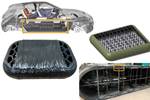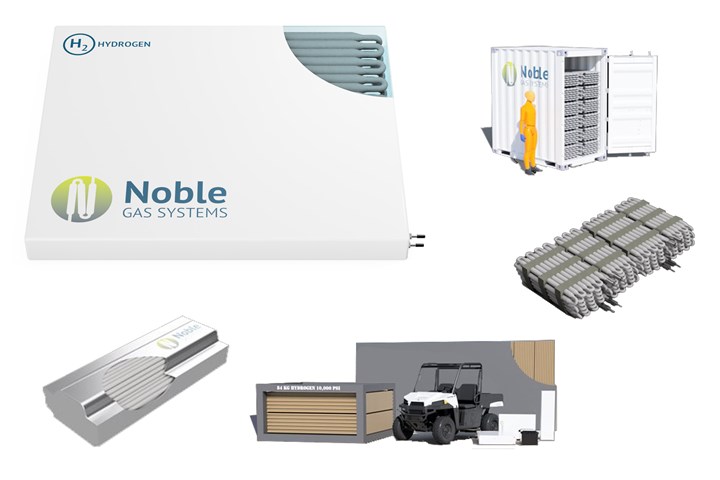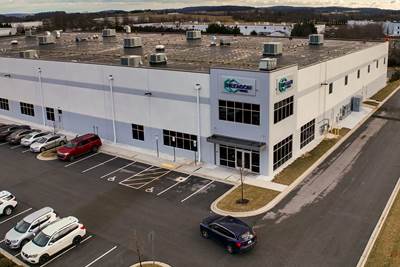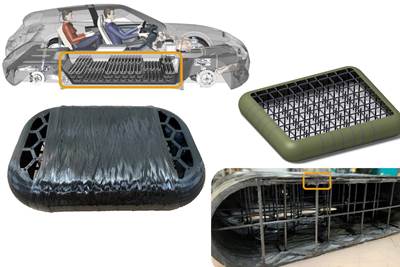Noble Gas Systems 350-bar conformable pressure vessels pass HGV2 standard tests
Conformable tanks with new materials pass technical tests for hydrogen storage, to compete with Type IV pressure vessels using CFRP.
Share
Read Next
Noble Gas Systems produces conformable tanks to store hydrogen for vehicles, bulk storage and other applications. Photo Credit: Noble Gas Systems
Noble Gas Systems Inc. (Novi, Mich., U.S.) is a developer and manufacturer of innovative, conformable high-pressure hydrogen gas storage tanks. Its conformable tanks comprise a polymer liner, braided fiber reinforcement and a protective outer shell. Although Noble Gas storage tanks do not rely on resin, and thus, are not a fiber-reinforced polymer (FRP) composite, they do provide a commercially viable alternative to Type IV composite storage tanks and one that can be configured to fit into the same flat space occupied by current battery enclosures for electric vehicles (EVs). Chris Kondogiani, CEO of Noble Gas Systems, spoke at CompositesWorld’s Hydrogen Tech Days event in 2021.
Noble Gas has announced that its conformable tank became the first-of-its-kind to pass a prescribed set of standard performance tests at 350 bar. This technical milestone proves that the company’s conformable tank technology is a viable solution for automotive, defense, aviation and bulk storage applications. Unlike current Type I, II, III, IV and V pressure vessels, Noble Gas tanks can be fabricated in a variety of shapes and sizes to fit into flat spaces within vehicles. They can also be easily integrated into unique and existing product configurations. The company also reports that its design may offer increased safety — it is working to demonstrate potential overpressure and crash benefits.
In addition to the automotive industry, Noble Gas conformable tanks are being prototyped for the defense, aviation, maritime and gas transport industries. With its 350-bar tanks now qualified per the HGV2 standard, Noble Gas is further developing its solution to provide 500-bar and 700-bar tanks as well. The Noble Gas high-pressure, lightweight storage and delivery system can accommodate most common compressed gases, including hydrogen, natural gas, air, oxygen and nitrogen.
Passing HGV2
The performance tests, conducted by certified third-party laboratories, validated eight hydrogen tank criteria from the ANSI/CSA HGV2:2021 standard, including burst, permeation, ambient cycle, extreme temperature cycle, hydrogen cycling, accelerated stress rupture, bonfire and penetration.
“This milestone brings us one step closer to offering our high-pressure, lightweight and conformable hydrogen storage system to the market,” says Kondogiani. “Many in our industry have questioned whether this type of tank could be feasible. Being the first conformable system to pass these rigorous performance tests validates our product as a valuable offering for a wide range of applications and demonstrates our technical leadership in this emerging field.”
Commercialization, scalability of technology
Earlier this year, Noble Gas was awarded a $1 million Phase II Small Business Innovation Research (SBIR) grant from the National Science Foundation (NSF) to support commercialization of its 350-bar (5,000 psi) hydrogen storage systems. In 2022, the company also received funding from AP Ventures, an investor in breakthrough hydrogen technologies, to further develop its conformable tank technology. But what will be commercialized and is it really a breakthrough technology?
“The prototypes we have already delivered have capacities ranging from less than a kilogram to over 10 kilograms of hydrogen, with customer systems in development up to hundreds of kilograms,” says Kondogiani. “Some are for small vehicles, but we are also targeting systems that are more affordable than Type IV tanks, as well as bulk storage systems. And we do believe our tanks can do things some other can’t. For example, they are lighter weight and can store more fuel in less space. For customers that are looking to store or transport hydrogen, those two things are important to them. That is our differentiator, not necessarily just being conformable. However, being space-efficient and the ability to put hydrogen tanks in places where manufacturers can afford the packaging space is also a benefit.”
But Kondogiani sees other benefits, including fast scalability and lower capex. “We think our approach is more scalable than making individual large cylinders, with a different design for each market,” he explains. “We’ve broken the paradigm of making a bigger tank, because it’s really about how much can you store. The way we manufacture, we just basically make a tank that has the capacity needed, and that’s easy for us to do, to tailor a tank system for a customer within the whole family that we have now qualified. And our approach enables a very large throughput without specialized winders and tooling for liners. So, we can get to the same endpoint as a Type IV tank manufacturer — e.g., 100,000 tanks at 10 kilograms of volume each — but with an economic value proposition at tank #1 instead of after 5,000 or 10,000 tanks produced.”
Dimensions, permeability and next steps
Within the system that has just passed testing per HGV2, Noble Gas can produce tanks with different diameters and lengths, says Kondogiani. “However, that doesn’t mean we have to. Different lengths are typically required as defined by the package space available. One of the first things we do when working with a potential customer is to define the tank enclosure length and how many linked vessels can fit into that package.”
What about the ability to meet permeability requirements with only dry fiber and no resin? “We’re using similar liner materials to what is used in Type IV tanks,” says Kondogiani. He concedes it is a little bit more challenging because Noble Gas tanks have a lot more surface area and a very thin wall. “To address that, we do some different things,” he adds, “but we have met the national specification and even ones that are coming out that are more stringent. In fact, if necessary, we can get permeability to zero, but we can't solve the latency problem. You're going to lose like 1% per month of hydrogen, but it won’t be hydrogen when it permeates. So, there are no emissions with our tanks.”
Kondogiani says this is a new phase for Noble Gas Systems. “We have finally put to bed the question of whether this technology will even work. We would talk with Tier 1 suppliers, and they would just assume that we’re using carbon fiber. When we’d explain that we’re using different materials, they would say our technology can’t work. We've now proven that not only does it work, but it can meet the same design qualification requirements that Type IV tanks can meet. Our goal was getting to this point where we have proven this is a viable way to make a tank and one that is not only competitive with Type IV tanks but offers distinct advantages. Our next step is to work with our prototype customers and start tests and certification for their specific tank systems, and then begin scaling up our production.”
Related Content
Polar Technology develops innovative solutions for hydrogen storage
Conformable “Hydrogen in a Box” prototype for compressed gas storage has been tested to 350 and 700 bar, liquid hydrogen storage is being evaluated.
Read MoreCollins Aerospace to lead COCOLIH2T project
Project for thermoplastic composite liquid hydrogen tanks aims for two demonstrators and TRL 4 by 2025.
Read MoreComposites end markets: Automotive (2024)
Recent trends in automotive composites include new materials and developments for battery electric vehicles, hydrogen fuel cell technologies, and recycled and bio-based materials.
Read MoreECOHYDRO project to enable recyclable composites for hydrogen storage
With the involvement of two schools from the Institut Mines-Télécom, the 4-year project aims to improve the intrinsic properties of a composite material based on Elium via four concrete demonstrators.
Read MoreRead Next
Hexagon Purus opens new U.S. facility to manufacture composite hydrogen tanks
CW attends the opening of Westminster, Maryland, site and shares the company’s history, vision and leading role in H2 storage systems.
Read MoreZeroAvia advances to certify ZA600 in 2025, launch ZA2000 with liquid hydrogen in 2027
Lightweight composite tanks are key to ZeroAvia’s vision for H2 aircraft to rival range and utility of jet fuel aviation.
Read MoreTU Munich develops cuboidal conformable tanks using carbon fiber composites for increased hydrogen storage
Flat tank enabling standard platform for BEV and FCEV uses thermoplastic and thermoset composites, overwrapped skeleton design in pursuit of 25% more H2 storage.
Read More






















